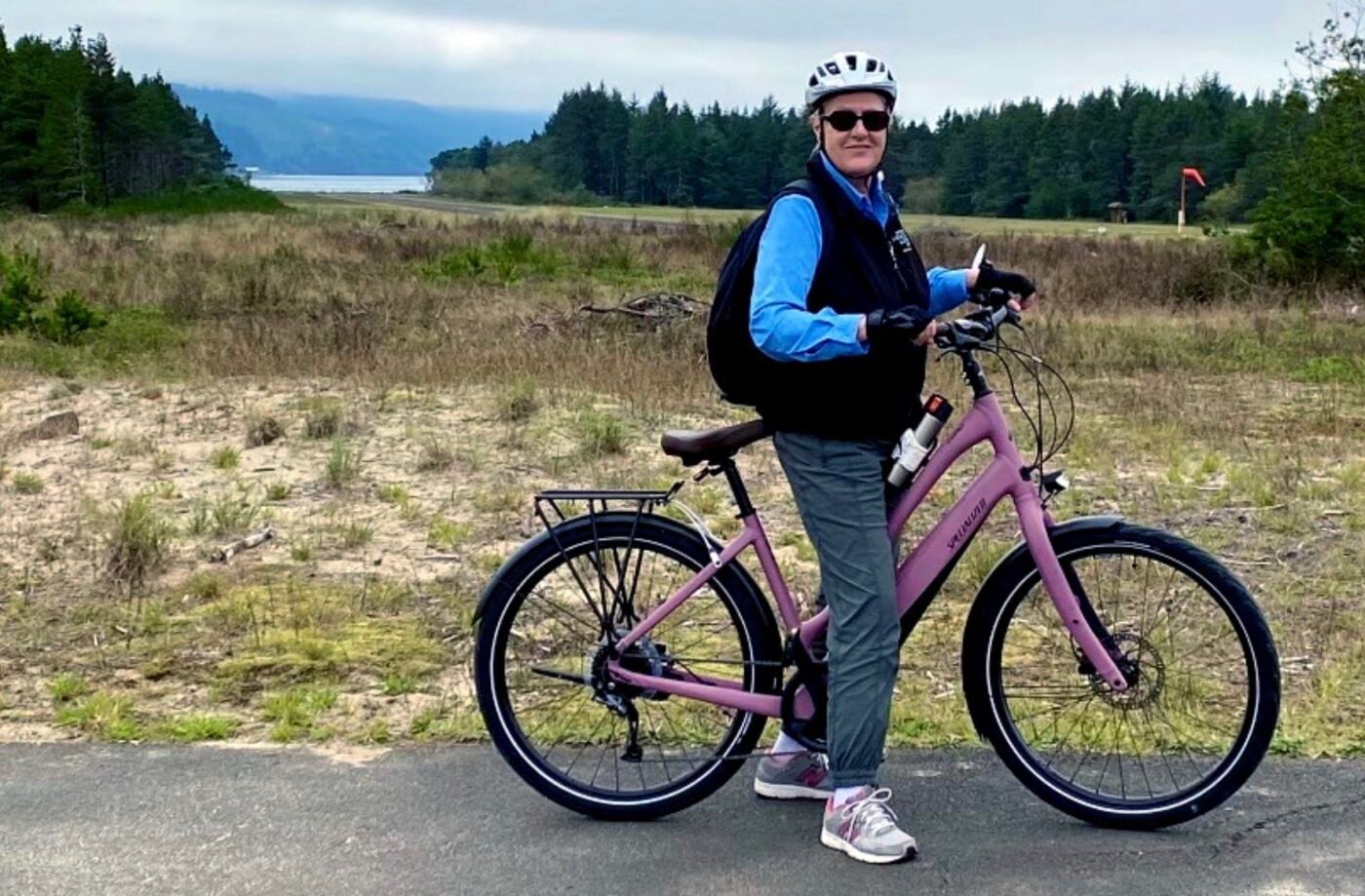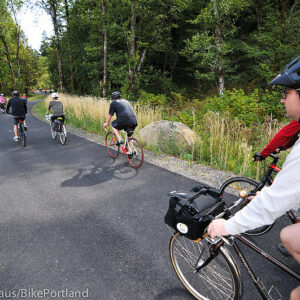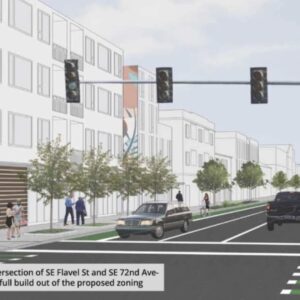The State of Oregon has taken an important step toward what could be a big change to where electric bikes can ridden. On Wednesday, the Oregon Parks and Recreation Department (OPRD) announced that the official rulemaking process has begun for where e-bikes can be used in state park properties and the Oregon Coast.
It’s the latest move as the State grapples with a boom in popularity of bicycles with motors. As we reported in 2017, e-bikes were technically illegal on any paved path within the state parks system until the rule was clarified in 2018. Currently, products that fit the legal definition of electric-assisted bicycle (ORS 801.258) are allowed on state park trails that are over eight feed wide (unless otherwise posted) and anywhere cars and trucks are allowed on the ocean shore.
According to OPRD’s statement this week, “The proposed changes would update definitions for electric-assisted bicycles and determine new locations where they are allowed and restricted.”
The OPRD Rules Advisory Committee will meet to discuss the changes at a meeting October 17th. The meeting agenda will include, “discussions on the impacts the proposed rules would have on visitor safety, recreational uses and conflicts, operational best practices and accessibility,” OPRD says. “The committee will also discuss the potential economic and fiscal impact of proposed changes.”
This move comes in response to a bill passed in the 2023 legislative session (HB 42013) that becomes law on January 1, 2025. That law will add more detailed e-bike definitions into the Oregon Revised Statutes: Class 1 (20 mph max speed with no throttle), Class 2 (20 mph max speed with throttle) and Class 3 (28 mph max with no throttle).
OPRD sought public comment on this issue last summer, so the rules committee will already have something to work with. After their initial meeting next week, three more meetings to discuss the rule will be announced. A public comment period will open in early 2025 once the newly proposed rule has been crafted and polished by the rules committee and OPRD staff.
Cycling advocates and e-bike users should watch this process very closely. Given that riding e-bikes is a relatively new and very widespread activity in state parks — and the fact that what many people consider “e-bikes” are often not — this new rule must strike a balance between access for and encouragement of e-bicycling, and keeping parks safe.
Learn more about the rule change and how the process will go from here on OPRD’s website.







Thanks for reading.
BikePortland has served this community with independent community journalism since 2005. We rely on subscriptions from readers like you to survive. Your financial support is vital in keeping this valuable resource alive and well.
Please subscribe today to strengthen and expand our work.
I believe that class 2 rules should work well. I live close to the longest and roughest going State Park in Oregon, east of Klamath Falls. I have always wanted to ride the whole length. A class 2 e-bike speed limit would work well and give people a better opportunity to enjoy this park and give supporting businesses the pleasure of meeting new people. Going 28 mph would be a death wish out here, or at least very painful. 20 mph would be adventurist enough…
Regulate behavior (speed limit) not the bike! This will also slow down some of the sport cyclists with no motor who think it’s ok to do a time trial on a MUP. Imagine if autos were regulated by how fast they can go -eg. any car with abilities to go 80mph would not be allowed in streets with lower speed limits. Posting speed limits on a trail makes more sense. I have a class 3 bike and am usually under 20mph, but on occasion, when it is safe to do so. Yet, I get passed by both e-bike and non-e-bikes. And, as with auto drivers, some bike riders will heed the speed limit, others will not but the class of the bike – whether or not it has a motor – is not the only issue.
How do you enforce behavior, though? You want Park Rangers out there acting like traffic cops on the state park MUPs?
How do you enforce the bike? Either system would require some type of enforcement. The reality is that most paths never see enforcement but users would/could see speed limit signs. Currently there are motorcycles and mopeds using the Springwater Trail (daily) and they aren’t getting tickets so a future where strained ranger and police budgets are dedicated to ticketing class 3 bikes just doesn’t seem too likely.
Telling me I can’t ride on a bike facility because I have a class 3 e-bike capable of 28mph bike is silly when I am not even riding 15 mph. Again, this would be similar to getting a ticket in a 20mph zone in your car, while going 15mph, because the motor can is capable of 100mph+.
And, I think 20mph is probably too fast for some MUPs… posting a speed limit sends a message to all users.When a speed limit is posted, it will give people – on all wheeled devices – clear guidance on behavior. Just as with any regs. in place currently, some will ignore but many will follow those rules.
I rode a pedal/electrical bike for the first time last summer on a very wide, mostly-paved 7- mile trail up by Mosier Tunnels. I use pedal power as much as possible (I have a background in physical exercise) but I am also 70 yrs old and have fibromyalgia. I rode 14 miles that day and had the time of my life! And while we were up there, I can’t tell you how many “older” people we saw also having a wonderful time on their e-bikes (most smaller than ours) but not going all that fast. They didn’t look like they could ride regular bikes that far, and I thought, “wow! What a great thing for older people who might otherwise not get out here that much!”
And then I read this article. I do hope the powers that be will take everything into consideration and that there won’t be any “ladder climbers” who just want to make a Name for themselves! Because that’s what seems to happen with government stuff, with little logic involved. bArbaroo, you made a great case for logic, here, and I really hope that stays part of the decision making process!
Cathey,Thanks so much for sharing your story. E-bikes really do get/keep more people riding. Whether due to age, injury, illness, or other condition there are many folks who, including me at times, can only bicycle if they have assistance. E-bikes keep me out of autos for sure (I’ve only driven 3 times in the last year). Without assistance, I would have to drive quite a bit more. And, I have one acquaintance that can’t drive legally due to blindness. They can see enough to cycle but not to obtain a driver’s license. They are able to do their errands everyday because an e-bike gets them where they need to go with the least hassle.
Yes, if we are to create more accessibility in parks and beyond, we need decisions based on logic,information, and facts, and not based on knee-jerk reactions or baseless opinion and fear. We also need a variety of voices speaking up, so I hope you stay engaged in the process.
Electric motorcycles belong on the road with their gas-powered peers. End of story.